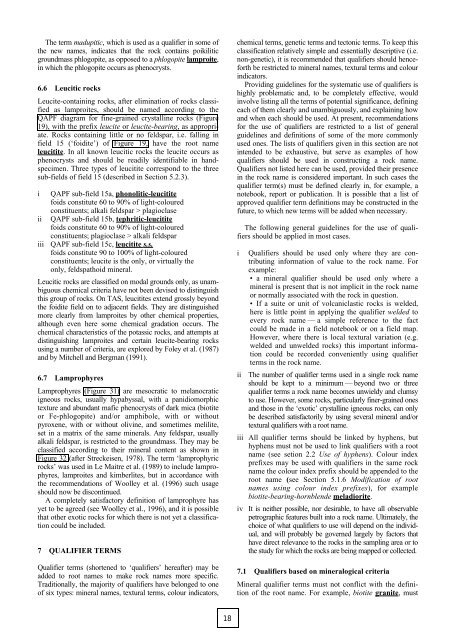Rock Classification Scheme (BGS).pdf - The Water, Sanitation and ...
Rock Classification Scheme (BGS).pdf - The Water, Sanitation and ...
Rock Classification Scheme (BGS).pdf - The Water, Sanitation and ...
Create successful ePaper yourself
Turn your PDF publications into a flip-book with our unique Google optimized e-Paper software.
<strong>The</strong> term madupitic, which is used as a qualifier in some ofthe new names, indicates that the rock contains poikiliticgroundmass phlogopite, as opposed to a phlogopite lamproite,in which the phlogopite occurs as phenocrysts.6.6 Leucitic rocksLeucite-containing rocks, after elimination of rocks classifiedas lamproites, should be named according to theQAPF diagram for fine-grained crystalline rocks (Figure19), with the prefix leucite or leucite-bearing, as appropriate.<strong>Rock</strong>s containing little or no feldspar, i.e. falling infield 15 (‘foidite’) of Figure 19, have the root nameleucitite. In all known leucitic rocks the leucite occurs asphenocrysts <strong>and</strong> should be readily identifiable in h<strong>and</strong>specimen.Three types of leucitite correspond to the threesub-fields of field 15 (described in Section 5.2.3).i QAPF sub-field 15a, phonolitic-leucititefoids constitute 60 to 90% of light-colouredconstituents; alkali feldspar > plagioclaseii QAPF sub-field 15b, tephritic-leucititefoids constitute 60 to 90% of light-colouredconstituents; plagioclase > alkali feldspariii QAPF sub-field 15c, leucitite s.s.foids constitute 90 to 100% of light-colouredconstituents; leucite is the only, or virtually theonly, feldspathoid mineral.Leucitic rocks are classified on modal grounds only, as unambiguouschemical criteria have not been devised to distinguishthis group of rocks. On TAS, leucitites extend grossly beyondthe foidite field on to adjacent fields. <strong>The</strong>y are distinguishedmore clearly from lamproites by other chemical properties,although even here some chemical gradation occurs. <strong>The</strong>chemical characteristics of the potassic rocks, <strong>and</strong> attempts atdistinguishing lamproites <strong>and</strong> certain leucite-bearing rocksusing a number of criteria, are explored by Foley et al. (1987)<strong>and</strong> by Mitchell <strong>and</strong> Bergman (1991).6.7 LamprophyresLamprophyres (Figure 31) are mesocratic to melanocraticigneous rocks, usually hypabyssal, with a panidiomorphictexture <strong>and</strong> abundant mafic phenocrysts of dark mica (biotiteor Fe-phlogopite) <strong>and</strong>/or amphibole, with or withoutpyroxene, with or without olivine, <strong>and</strong> sometimes melilite,set in a matrix of the same minerals. Any feldspar, usuallyalkali feldspar, is restricted to the groundmass. <strong>The</strong>y may beclassified according to their mineral content as shown inFigure 32 (after Streckeisen, 1978). <strong>The</strong> term ‘lamprophyricrocks’ was used in Le Maitre et al. (1989) to include lamprophyres,lamproites <strong>and</strong> kimberlites, but in accordance withthe recommendations of Woolley et al. (1996) such usageshould now be discontinued.A completely satisfactory definition of lamprophyre hasyet to be agreed (see Woolley et al., 1996), <strong>and</strong> it is possiblethat other exotic rocks for which there is not yet a classificationcould be included.7 QUALIFIER TERMSQualifier terms (shortened to ‘qualifiers’ hereafter) may beadded to root names to make rock names more specific.Traditionally, the majority of qualifiers have belonged to oneof six types: mineral names, textural terms, colour indicators,chemical terms, genetic terms <strong>and</strong> tectonic terms. To keep thisclassification relatively simple <strong>and</strong> essentially descriptive (i.e.non-genetic), it is recommended that qualifiers should henceforthbe restricted to mineral names, textural terms <strong>and</strong> colourindicators.Providing guidelines for the systematic use of qualifiers ishighly problematic <strong>and</strong>, to be completely effective, wouldinvolve listing all the terms of potential significance, definingeach of them clearly <strong>and</strong> unambiguously, <strong>and</strong> explaining how<strong>and</strong> when each should be used. At present, recommendationsfor the use of qualifiers are restricted to a list of generalguidelines <strong>and</strong> definitions of some of the more commonlyused ones. <strong>The</strong> lists of qualifiers given in this section are notintended to be exhaustive, but serve as examples of howqualifiers should be used in constructing a rock name.Qualifiers not listed here can be used, provided their presencein the rock name is considered important. In such cases thequalifier term(s) must be defined clearly in, for example, anotebook, report or publication. It is possible that a list ofapproved qualifier term definitions may be constructed in thefuture, to which new terms will be added when necessary.<strong>The</strong> following general guidelines for the use of qualifiersshould be applied in most cases.i Qualifiers should be used only where they are contributinginformation of value to the rock name. Forexample:• a mineral qualifier should be used only where amineral is present that is not implicit in the rock nameor normally associated with the rock in question.• If a suite or unit of volcaniclastic rocks is welded,here is little point in applying the qualifier welded toevery rock name — a simple reference to the factcould be made in a field notebook or on a field map.However, where there is local textural variation (e.g.welded <strong>and</strong> unwelded rocks) this important informationcould be recorded conveniently using qualifierterms in the rock name.ii <strong>The</strong> number of qualifier terms used in a single rock nameshould be kept to a minimum — beyond two or threequalifier terms a rock name becomes unwieldy <strong>and</strong> clumsyto use. However, some rocks, particularly finer-grained ones<strong>and</strong> those in the ‘exotic’ crystalline igneous rocks, can onlybe described satisfactorily by using several mineral <strong>and</strong>/ortextural qualifiers with a root name.iii All qualifier terms should be linked by hyphens, buthyphens must not be used to link qualifiers with a rootname (see setion 2.2 Use of hyphens). Colour indexprefixes may be used with qualifiers in the same rockname the colour index prefix should be appended to theroot name (see Section 5.1.6 Modification of rootnames using colour index prefixes), for examplebiotite-bearing-hornblende meladiorite.iv It is neither possible, nor desirable, to have all observablepetrographic features built into a rock name. Ultimately, thechoice of what qualifiers to use will depend on the individual,<strong>and</strong> will probably be governed largely by factors thathave direct relevance to the rocks in the sampling area or tothe study for which the rocks are being mapped or collected.7.1 Qualifiers based on mineralogical criteriaMineral qualifier terms must not conflict with the definitionof the root name. For example, biotite granite, must18
















